Franz Kröger
CULTURAL HERITAGE AND TOURISM
The two components of our new main
feature, "Cultural Heritage" and "Tourism", do not seem to have very much in
common at first sight. Nevertheless, both are concerned with the highlights of
Bulsa culture. Only the viewpoint is different. In the context of "cultural
heritage", we may consider Bulsa customs, ritual and secular events and
festivals, historical events with far-reaching consequences and, lastly,
outstanding objects of material culture or the fine arts which were handed down
by ancestors to the present generation.
A tourist is a stranger who, at
best, wants to broaden his or her intellectual horizons by acquiring knowledge
of other cultural forms without spending too much time in grasping the inner
nature of the culture being visited. They are often interested in exotic and
entertaining elements such as dances (in the case of the Bulsa, it would mainly
be the war dance), festivals of all kinds, the colourful market life, etc.
When dealing with historical events, the targets of interest are slightly
different. While the story of ancestors, the founding of villages, or
immigrations from other ethnic groups (e.g. Atuga coming from Mamprusiland) are
of great importance to all Bulsa, the tourist is often more interested in
acquiring further knowledge of well-known global issues such as colonialism and
slavery, which are now connected with corresponding events in the Bulsa area. In
order to address both aspects, this magazine has selected individual themes from
different areas of Bulsa culture which may be attractive to tourists but can
also serve to deepen the knowledge of educated Bulsa especially. These themes
include, for example:
1) Historical sites and monuments
The very extraordinary caves and
hollow trees used for refuge will certainly be an attraction to tourists who are
interested in history, particularly in West Africa's slave raids.
2) Religion
Ancestor veneration is certainly a
central cultural institution regulating more than just religious matters.
Through the rotation of ancestral shrines within one lineage, economic and
social matters are also regulated within this group. The rotation system, which
is very difficult to understand by outsiders, can be exemplified by visiting a
compound with a long row of ancestral shrines in front of the entrance.
3) Native music and dance
Performances of native dance and
music are a "must" in the expectations of tourists, and they appear prominently
in all programs for tourist excursions in West African countries.
In our article, we simply list the
common Bulsa dances, as they appear on numerous occasions of Bulsa festive and
ritual life.
4) Technologies and products of
material culture
Weaving mats and baskets, forming
ceramic vessels in the coiled method, forging iron tools or creating brass
figurines using lost-wax casting:
all these techniques are attractive to tourists and are part of guided tours,
similar to those led in other countries.
Out of all the Bulsa objects of
material culture, I have only touched on the busik basket here in a
separate chapter because of its unique production, shape and usage. One of the
preconditions for flourishing tourism in the Bulsa area will be a new Bulsa
museum, and it would be there that other aspects of material culture could be
explained.
1.
Historical Sites
In the historical memory of the
Bulsa, the battles against the slave raider Babatu, as they took place mainly in
Sandema and Kanjaga, play a large role. They give rise to questions like: "Which
Bulsa villages participated in these and other battles? How did these battles
turn out? Where exactly did they take place? Are there any traces left today?"
Non-Bulsa tourists would probably
show less interest in these questions. The exact locations of the battle-grounds
are controversial, and even if one considers a certain site to be the very
battle-ground, it offers little that makes a long tour to a remote area
worthwhile.
This might be changed if the site
can offer interesting objects associated with the battle. In Fiisa, near the
Azagsuk tanggbain, something like that has already been arranged.
Visitors are shown traditional weapons, jewellery and parts of rifles used in
the battles by or against the Zabarima. Information about such objects could be
conveyed by an expert guide with a good knowledge of English or via a short
informational brochure in English.
In this context, for example,
stories about the battle south of Sandema could be told to the victors near the
Akumcham-sheabutter tree on which the corpse of one of Babatu's wives was
displayed.
The places where Bulsa took refuge
from Babatu's raids may be more interesting for tourists than the
battle-grounds. Caverns of refuge are probably scattered over the whole of the
Bulsa area, but I know of only three such caverns in Wiaga, which in their plans
and construction differ fundamentally from others in Northern Ghana.
Tourist might be shown the
well-preserved Posuk Cavern to the south-west of Wiaga. In the time of Babatu,
the cavity in the rocks was completely invisible from outside, and people could
enter it only through a man-made shaft and a tunnel ending in the natural cave.
Here the fugitives, especially old people, women and children, were crammed into
this small room (Kröger 2008, p.33). Today the shaft and tunnel are partly
blocked by stones and sand, which might be removed before the first visiting
tourists appear.
Hollow baobab trees might have
offered a smaller refuge for about 5-6 people. One of these trees, situated near
Pung Muning Hill (Wiaga), might be visited by tourists, too.
Imparting knowledge about Atuga, the
founder of the Atuga-bisa, will involve similar problems. Conjectures about his
home and workplace are either controversial or inaccurate. The starting point
for an oral introduction might be Atuga-bogluk, the big ancestral shrine
at the entrance of Kadema. Here, a guide can tell stories about Atuga's
departure from Nalerigu, the first settlements in Bulsaland and the myths about
the foundations of Kadema, Sandema, Wiaga and Siniensi by Atuga's sons Akam,
Asam, Awiag and Asinieng.
2.
Ancestral Shrines (bogluta)
Note: For Buli bogluk (pl. bogluta)
I prefer the English translation "shrine" because "altar" does not sugget
the fact that the supernatural being is staying in the sacrificial stone of the
bogluk. "Fetish" has too many negative connotations while "god" is
utterly wrong. Ancestors do not become gods after their death, although their
wen (see below) is a divine element.
In many West African societies, it
is quite difficult for a stranger to acquire a detailed knowledge about a
group’s ancestors, their names, their shrines and their significance to their
living descendants. It is not unfriendliness when they refuse to answer certain
questions, but they do not want to anger their forebears by telling secret
details about them to strangers. Even in some Bulsa compounds outside of Wiaga,
some compound heads hesitated to inform the inquirer about which ancestor is
venerated in which shrine.
Many Bulsa, however, especially
those with whom I’m familiar in Wiaga, have a different mentality. Anamogsi, an
elder of Wiaga-Badomsa, told me, "The ancestors and tanggbana
(earth-shrines) like all people who do not come to them with evil intentions".
In his compound his youngest son incised the names of all important ancestors
into their mud shrines, and this makes understanding the ancestral system much
easier for visiting strangers.
The connection between ancestors as
important and powerful figures of a compound and as spirits that receive
sacrifices in shrines will be described in a concise way below. Most strangers
will not expect such a complicated system that is based completely on strictly
logical premises. It can be regarded as a comprehensive explanation and answer
to the frequently asked question: "What is the meaning of these mud
constructions in front of the compound"?
The compound head (yeri nyono)
will voluntarily tell the visitor that the mud shrines are the residence of
the male ancestors of the compound. Their placement is not arbitrary.
Rather, they are (or ought to be) in one line with the kpilima dok
(ancestors' room), the main grain store (bui) and the front
entrance (nansiung). All humans should treat these shrines with respect
and reverence, but there is no general fear in using the shrines for other
secular purposes, e.g. as benches. When I once tried to take some photos of a
tigi (secular festival) in front of Anyenangdu Yeri (Wiaga-Badomsa), the
yeri-nyono (Anamogsi) invited me to stand on the biggest shrine for a better
overview.
To understand the significance and
meaning of the ancestral shrines, some further explanations are necessary. It is
clear that the line of shrines is arranged according to size: The youngest
ancestor has the smallest shrine while the oldest may be so big that sacrifices
can only be made when the sacrificer climbs on it. For every ancestral
generation there is usually only one shrine, meaning that the oldest ancestor in
a line of six shrines lived six generations before the youngest
1.
There are round quartz stones (tintankoa, sing. tintankori) in the
centre of the shrines' surfaces. It is here where the ancestral wen - the
divine component - is located and where it receives sacrifices.
Some of the cylindrical mud
constructions have two or more wen-stones. While the line of shrines
represents the lineal or vertical genealogical aspect, the additional wen-stones
represent the lateral or "brother" relationships to the main shrine inhabitant.
These brothers cannot have a shrine of their own because they have no male
descendants to sacrifice to them. But as shrine-mates of their brothers, they
can take part in the sacrifices offered to the ancestors with male descendants.
Or, as an informant put it, "Some of the sacrificed blood will flow from the
main to the second stone".
There may be other attachments in or
near the main ancestral shrines: A medicine shrine, which is a ceramic vessel
with water and roots, may even receive part of the sacrifice. A piece of iron
representing a knife may be imbedded in the surface of the shrine and is
supposed to protect the human inhabitants of the compound against any unwelcome
intruders. In a Sandema shrine of a male ancestor, I even recognized a knobbed
vessel representing the ancestor's mother
2.
The "owner" (nyono) of the
line of ancestors, usually the head of the compound, holds a number of titles.
1) He is the sacrificer and official
organiser of every sacrifice and will intone the prayers to the ancestor. He
also performs sacrifices to the shrines acquired by one of the ancestors, e.g.
earth-shrines (tanggbana), medicine-shrines (tiim-bogluta) or
shrines of certain bush-spirits (jadok-bogluta).
2) He is the elder (kpagi) of
all descendants of the oldest ancestor. On the one hand, as the lineage head, no
important action within his lineage (e.g. founding a new compound) may be
performed without his permission. On the other hand, the kpagi cannot
sell cattle belonging to one of his ancestors without the permission of the
ancestor's other living descendants.
3) He is the owner of all the land
and cattle (respectively, their offspring) acquired by one of the ancestors. If
a stranger (e.g. a tourist) visits a compound with a long line of big ancestral
shrines, he may be sure that the yeri-nyono is not a poor man.
When the head of the compound has
died, the inheritance of his ancestral bogluta may be a complicated
affair and may even cause inter-lineage conflicts. The rule is that the most
senior living male descendant of the most senior generation will be his
successor. Usually this descendant is not living in the deceased elder's
compound, which means that the shrines have to be transferred to the successor's
compound
3.
After the new owner has died, the
bogluk is again transferred to the compound where the then-most senior man
of the lineage is living. Over the course of time, the ancestral bogluta
may thus rotate through all the houses of the lineage. It should be remembered
that not only is the mud-shrine subject to rotation. Also the social position
of the kpagi, large areas of land as well as large numbers of cattle are
included. The
rotational system gives every male member of a lineage the chance to become a
very rich man overnight after the death of the hitherto richest man.
European tourists will be impressed
hearing about such a system and will probably compare it with European systems
of distributing economic commodities after a person's death.
ENDNOTES (Ancestral Shrines)
1This is not always the
yeri-nyono's father since his shrine may still be in the compound if the
final funeral celebrations for him have not been performed yet.
2
Usually shrines of
ancestresses can be found as vertical stones on a footpath leading to the
woman's parental compound or as a knobbed vessel in the kpilima dok (the
ancestors' room) inside the compound.
3
It is not the whole mud shrine that is transferred, but only the white
sacrificial stones (tintankoa) for which a new mud construction is built
in the new compound.
3.
Bulsa Dances
When I was
impatiently waiting for my first opportunity to visit Bulsaland in 1973, I
discovered a photo of a Bulsa war dance group in the Daily Graphic
newspaper of January 5, 1973. They were performing their dance at the Fiok
festival of Sandema. The photo certainly aroused the attention of the southern
Ghanaians, too. One month later, on February 2, 1973, the Daily Mirror
published photos of Bulsa performing a war-dance during the Agricultural Show in
Zuarungu.
Bulsa dances, especially the war dance, are the hallmark of the Bulsa for
outsiders, and they also attract a great deal of attention by non-Bulsa.
Demonstrations of dances outside of the Fiok Festival would surely be a tourist
attraction within Bulsaland.
Although observers experience these dances and the accompanying music more
emotionally as an aesthetic performance, some data on the Bulsa dances will be
listed here.
3.1 The War Dance (leelik,
pl. leelisa)1
This dance is certainly imitating a
bull or buffalo when the dancers step forward very slowly, step backward
quickly, stamp their legs on the ground and turn the upper part of their bodies
backward while rotating it. Complimenting these dancing movements, the war
dancer wears a helmet to which buffalo horns or, more rarely, of a domesticated
bull have been attached.
A war dance may have the following
rhythmical pattern:
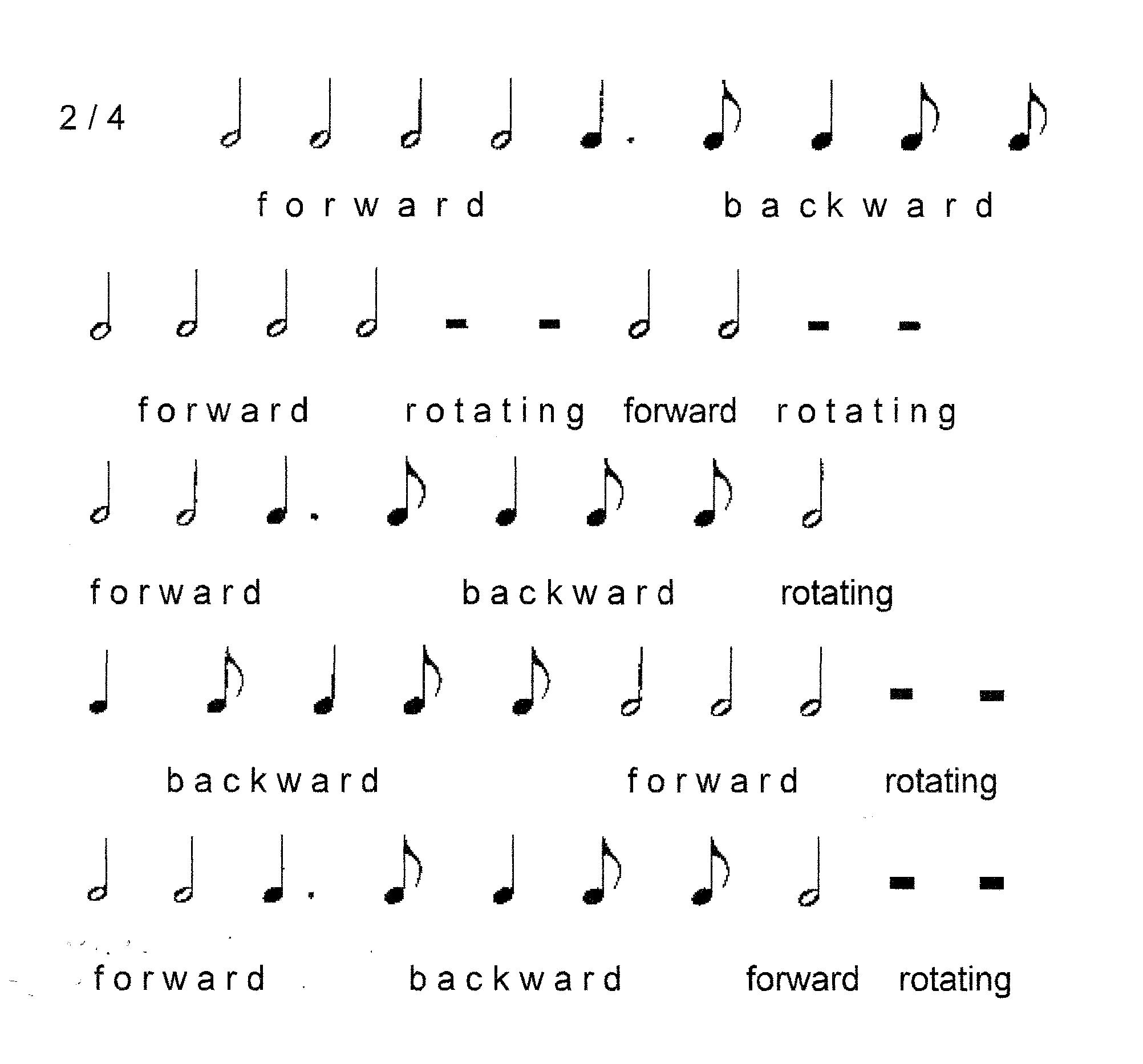
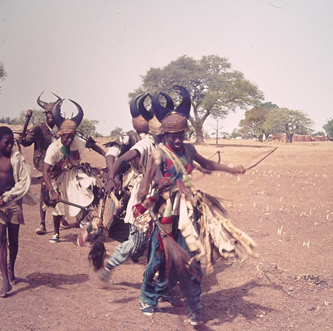 |
|
A war dance om Sandema-Kalijiisa 1973 |
We do no know anything about the
origin of this dance. For fighting in battles and particularly for hunting, the
heavy helmet with the cumbersome horns is not the ideal equipment. By contrast,
the calabash cap, which is probably older than the horned helmet, is certainly
more suited.
Perhaps the origins of the dance are
associated with magical rituals. By adopting the appearance and behaviour of a
buffalo, the hunter might obtain power over the dangerous animal.
Among all the traditional Bulsa
dances, only the war-dance demands a particular costume, which is similar to
that of a hunter’s or warrior’s. The following dresses, arms and decorations can
be found among war-dancers:
• a war helmet consisting of a woven
skull-cap and the two horns of a buffalo or a domestic bull
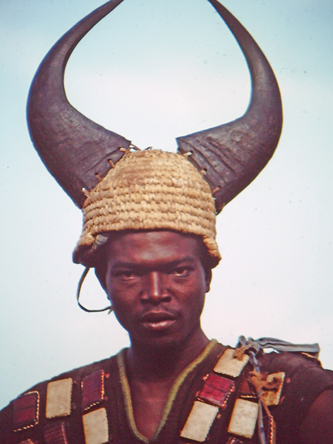 |
|
War helmet and saba smock |
• a traditional short smock
(garuk), often dyed brown (as camouflage) and often studded with charms
embedded in rectangular leather cases (saba). Such a smock is called
saba-garuk.
• a tangkalung, a leather or
skin apron which is often a goat's skin
• the traditional kurik-koluk
trousers, which today are often replaced by Western trousers, e.g. jeans
• many bangles, among them one
(poali) which protects the shooter’s arm from the bow-string
• the arm quiver containing
un-poisoned arrows (arrows are poisoned before a hunt or battle)
• the cylindrical or flat wooden
quiver at the warrior's left side with spare arrows. Various objects may be
fixed to the quiver: charms in leather cases, fly whisks, hunting trophies, many
skins of animals, brass or iron bells (longa) and changsa (iron
idiophones, wrongly called finger-bells). I even once saw a living fowl fixed to
the quiver of a dancer.
• the footwear may consist of modern
sandals. In the past sandals were made from thick elephant skins and somewhat
resembled the modern sandals made from car tyres.
• an axe in his right hand. Today
they are without iron blades, and the upper part is sometimes shaped like the
head of an antelope.
• instead of the axe-handle, a
flywhisk may be held in the right hand. It consists of an animal tail (usually
horse) and a big leather handle, usually containing charms.
• a bow held by the dancer in his
left hand
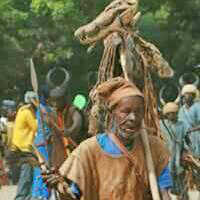 |
|
The stick with magical objects and trophies |
Sometimes an old man, holding a
stick with various objects fixed to its top, joins the war-dancers. The objects
on the stick may in part be trophies as, for example, the crocodile's head in
the photo2 or they may in part be magical
things that ward off evil from the dancers.
The dancers are unmasked. James
Agalic, however, obtained information from older community members confirming
that in the past men also danced in a costume called tanjangi
(pl. tanjanga), which consisted of big bundles of long grass that hid the
face of the dancer. In this disguise, war-dances might also have been performed
in the past. In hunting expeditions, the grass might have been a suitable
hunting camouflage because it permits the hunter to approach a wild animal
without being discovered too soon.
Today the musical instruments
accompanying a war-dance may consist of the following, although some of them are
not used in every dance;
• the small and middle-sized
cylindrical drum (ginggaung-diak and ginggaung chogsung), but
never the big drum (ginggaung-nubi)
• the kantain horn-trumpet,
though not the similar-looking namuning
• one wooden tapiliok or
yui-poliok flute, an instrument that was also used before a hunting tour or
a raid. As this type of flute has become rare today, it is usually replaced by a
tagalik-flute.
• playing one or two senlengsa
double bells is apparently optional.
Today the leelik is danced on
only a few occasions such as funerals and big festivals. The Fiok festival in
Sandema or the installation of a new chief will include the leelik, for
example. When the dancers are invited to big festivals outside the Bulsa area,
they will also dance it.
Usually on the second day of the
kumsa-funeral, war-dance groups from the deceased man's section as well as
neighbouring sections appear in their full costumes. Before the guest group is
allowed to dance, they visit the death mat (ta-pili) of the deceased in
the
 |
|
A boys' group in Sandema Kalijiisa 1973 |
cattle yard of the compound. The dancing-group of the deceased man's lineage
is led by the deceased's eldest son who dances as the first warrior of the line.
Often this group visits the tanggbain of the ritual section. Their own
compound may be surrounded by the group before it walks to the original (usually
abandoned) settlement (guuk) of the deceased's ancestor where dances are
also performed.
In addition to the dancing groups of
adult men, many sections have groups made up of small boys. They do not wear the
horned helmets but rather calabash caps often consisting of only a large sherd
with two stalks on it representing the horns. Like the adult warriors, they also
hold a bow in their left hand and the wooden handle of an axe in their right.
Instead of a quiver (or the tankalung leather apron?), they wear a bundle
of short millet (or bamboo?) stalks.
These boy-groups are not a parody
but are highly respected by the adults. Before starting their dances, they also
visit the death mat in the cattle yard. Women are not allowed to dance the
leelik, but they may accompany the group of men with a cloth to wipe off the
sweat of a dancer when necessary.
3.2 Gokta3
The gokta-dance is perhaps
the quickest Bulsa dance and requires a lot of energy from the male or female
dancer. It is mere entertainment for the dancers and spectators.
The participants and spectators form
a circle, while two drums4
are beaten in a
relatively simple rhythm. Usually one young man or woman (though on rare
occasions, two) jumps into the circle and starts dancing on the spot by raising
one knee by turns in a very quick manner. The hands of women dancers are held
upwards in rhythmical movements while the hands of a male dancer move at chest
height. The dancing steps of women are slightly different from those of men and
their knees are not raised as highly.
As the dance is very exhausting, one
solo dance rarely takes longer than one or two minutes. Before the dancers
rejoin the spectators, they may request another person to dance. Spectators who
have a particular affinity for a dancer or his/her dance may press a coin or a
banknote on his/her wet forehead.
3.3
Duelingka
This is a striding dance with a
complicated rhythm. The dancers are accompanied mainly by drums, most of which are ginggana-cylindrical
drums, though there are also calabash-drums (goa, sing. gori),
hourglass-drums (gunggona, sing. gunggong) and, very rarely, a
pair of basketry rattles (sinyaala or sinsangula) present.
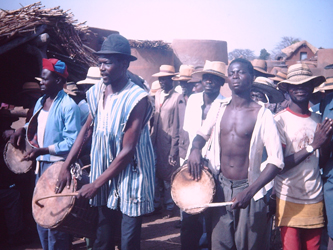 |
|
Musicians, elders and mourners surrounding the compound |
If the duelingka-dance is
performed by specialized Bulsa dancing groups, it can also be danced in a line
or a circle.
3.4. Din-jim
At funerals this dance is performed,
when elders, often accompanied by big crowds of mourners and visitors, are
surrounding the funeral compound in rather slow steps. The accompanying
instruments are similar to those of the duelingka-dance.
3.5
Nagela
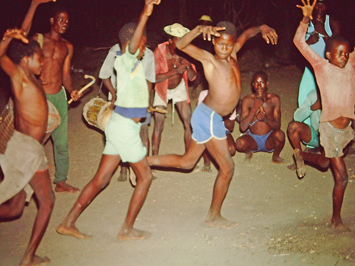 |
|
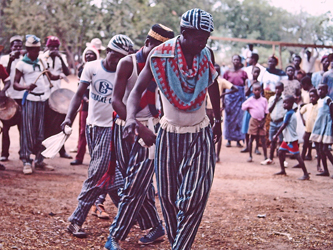 |
| Nagela-dancers in front of a
compound |
|
Nagela-dancers at a big festival |
According to Peter Angaaba Atesiuk,
this dance was performed to escort a group of chiefs (na< naab, chief) or
elders when they were walking to a meeting, thus summoning a blessing from above
(i.e. God)5.
Today the Nagela
dance is danced mainly as an entertainment by men and, rarely, by women. The
dancers form long rows and, similarly to the war dances, move forward and
backward. Their arms are thrust up, and they often hold animal tails or bunches
of leaves in their hands. According to Angaaba, throwing up their hand is called
"chogsi chingmarika [or], chogsi gambani" (i.e. 'catching the
star' or 'catching the sky'). By these movements the blessing from above is
invoked.
There may be different musical
instruments accompanying the dancers: 2-3 cylindrical drums, alternatively 2-3
calabash drums (goa or goe), 2-3 or more flutes (yuisa), or
alternatively 2-3 horn trumpets (namunsa).
3.5 Small ritual dances
Some ritual dances of short duration
will probably never be performed before tourists' eyes but should be mentioned
here to complete the list.
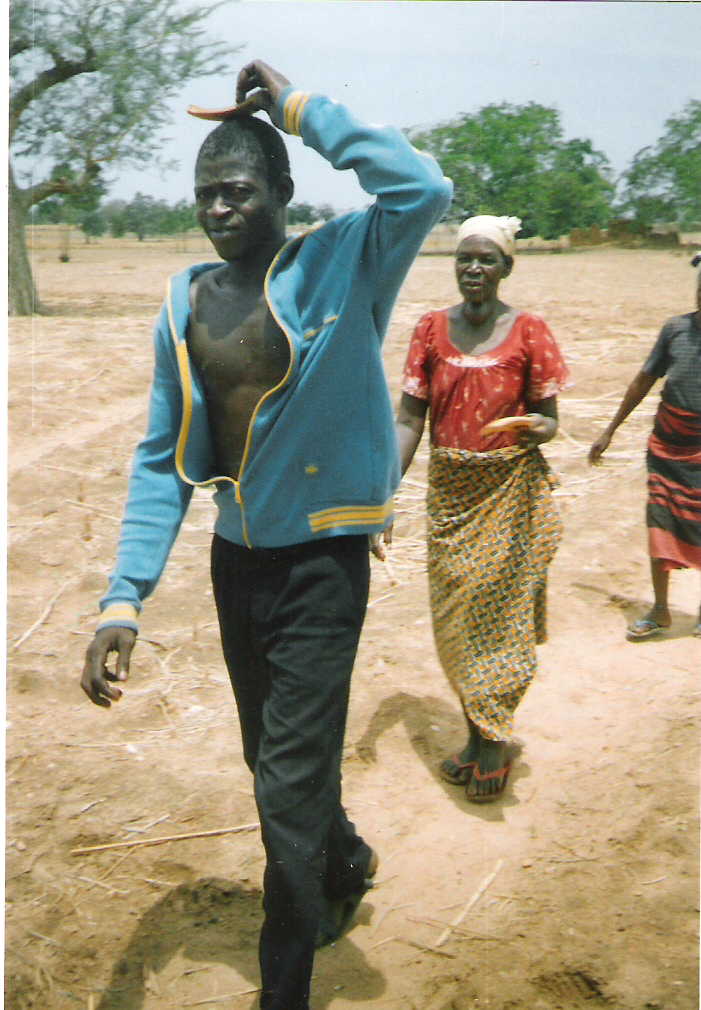 |
|
Young man dancing the senlengsa-dance |
• After the ceramic and
calabash vessels of a deceased wife have been ritually destroyed in the second
funeral (juka), the women who performed this ritual act dance the
senlengsa-dance on the sherds. While dancing they balance one potsherd on
their heads. They are accompanied only by the double-bell (senlengsa). On
rare occasions, men may join this dance (see photo).
• The following ritual dance can
only be performed at nighttime. When a new soothsayer (baano) is
initiated into his new office by an old and experienced soothsayer, his fellow
soothsayers from the same section assist him by performing a dance around the
neophyte who is inhaling the smoke from burning, half-charred medicine. While
dancing with their rattles in their right hands, they sing:
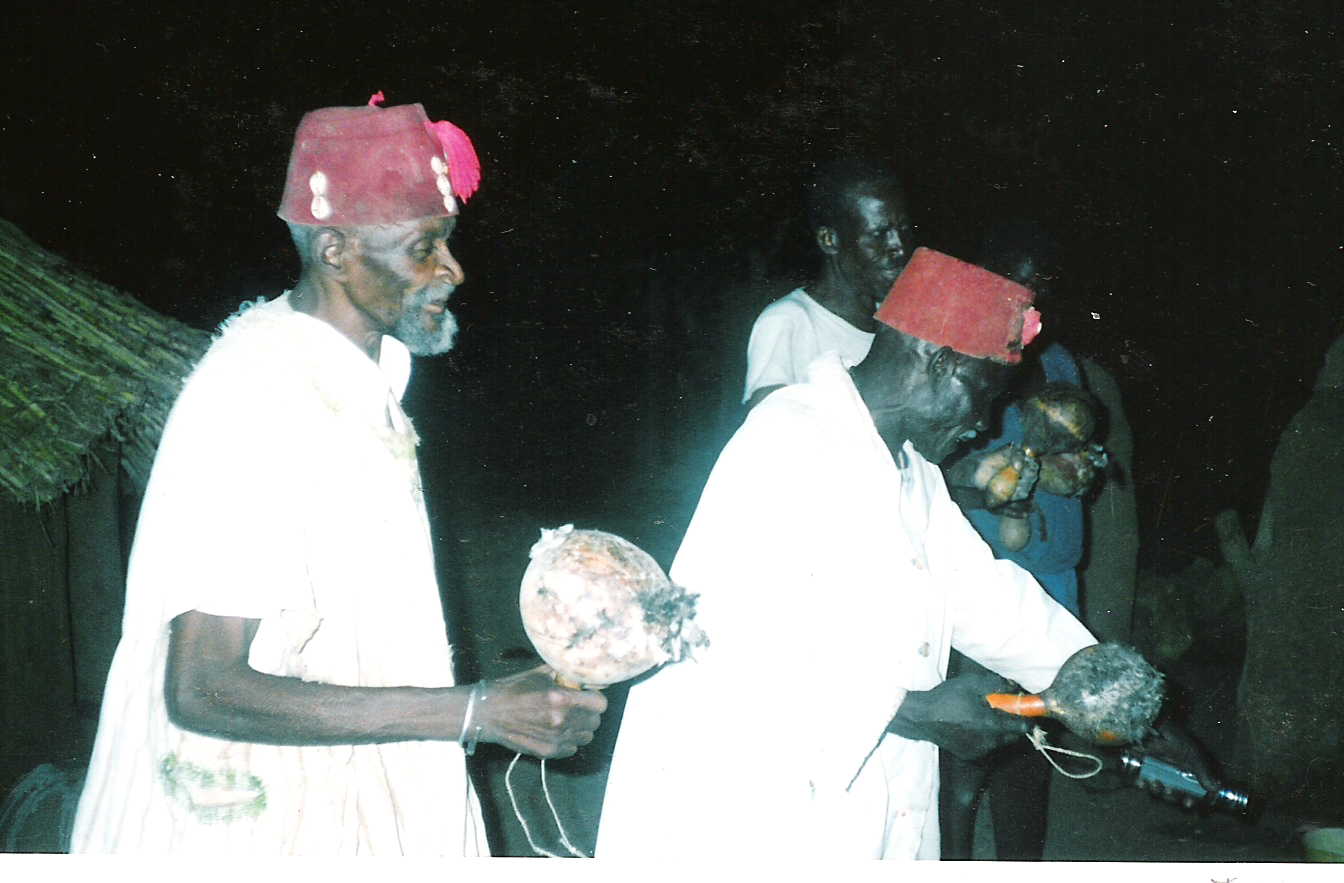 |
|
Soothsayers dancing during an ordination
(Sinyangsa-Goldem) |
Baano a chabli tiimu. - Nipok a
chabli tiimu.
(A soothsayer is inhaling the
medicine. - A woman is inhaling the medicine)
Before they stop their dance, each
of the dancers strikes the head of the then-unconscious neophyte with his
rattle.
• A short dance is performed after
the birth of a baby by the midwife and her assistants on the spot where the
placenta of the new born baby has been buried.
3.6 Occasional Dances
All Bulsa, young and old, male and
female, like dancing. It is not only the ritual dances and the dances for
entertainment that they enjoy. Whenever there is an occasion or they hear
rhythmical patterns, they may perform solo-dances.
When two women with naked breasts
are tired of grinding shea nut butter, they dance the so-called buluk-sangula6-dance.
They beat their naked arms in a particular rhythm against their hips so that a
peculiar sound is generated in their arm-pits (bulukta, sing.
buluk).
3.7 Innovative Dances
 |
|
Koku-lag-siuk-te n taam |
• In addition to the traditional
standard dances, semi-professional Bulsa dancing groups perform dances which can
often be recognized as non-traditional by their names (e.g.):
Paati-paati-paapa (paati: Engl. 'party', paapa: Twi 'good').
The original song on which the dance is based was popularized in Africa and
other parts of the world by the South-African singer Miriam Makeba and is
usually known by its name Pata-pata.
• Another new and popular dance is
called "Koku-lag-siuk-te n taam" (The Ghost Opens the Way that I Can
Pass). In 1988 it belonged to the standard dances of the Badomsa dancing group.
ENDNOTES (Dances)
1A more detailed description
of the dance can be found in Kröger 2001: 640-41, of the use of musical
instruments ibd. p. 732.
2
Source of the
photo: Ka-wenboka Hutchinson in the Facebook group Buluk Kaniak, November
9, 2017. Photo: the late Baba Adiivum from Fiisa with his trophies and charms.
3
Gokta can also be a general term for all dances, cf. gogi,
to dance.
4
According to James Agalic (via oral communication), in the past, 2-3
calabash-idiophones were used instead of the drums.
5
Post in the Facebook group "Buluk Kaniak" (July 5, 2017). Angaaba
associates the syllable ge with Buli geb, whose basic meaning is
"to cut", but is allegedly used here with the meaning of "to guide".
6
Sangula means a basket-like rattle. At least today, no rattle
is beaten to accompany this dance.
4. The Busik Basket - the
Squaring of the Circle
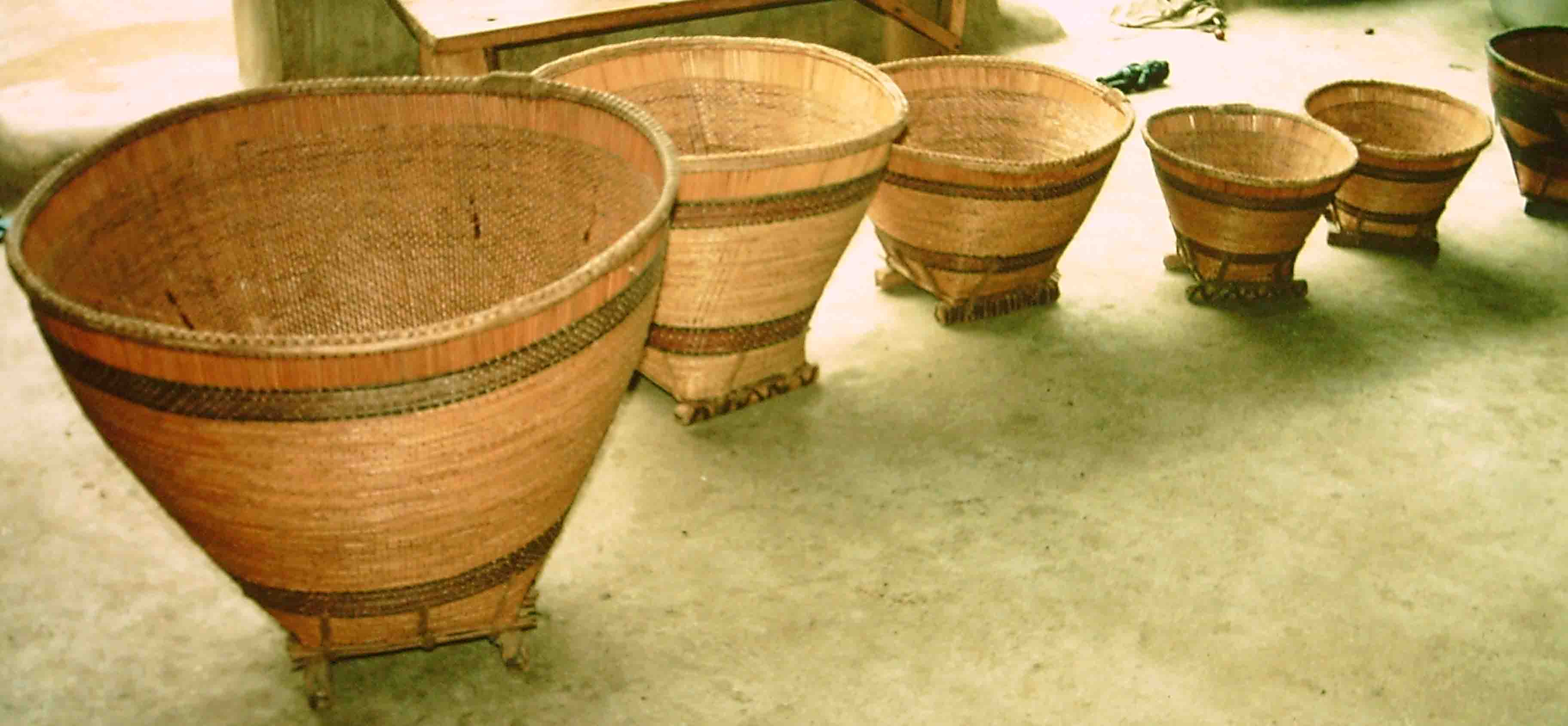 |
|
Fig. 1. Busik-baskets in the Wiaga
Chief's household |
If an
English-speaking Bulo is asked for a translation of the English word "basket",
one can be sure that the answer will be "busik". A basket of any type
acquired in Southern Ghana may be called kambonsa-busik, while a certain
Frafra basket, made of the stalks of a certain type of grass known as
kpingkpiak (Vetiveria fulvibarbis), is a kpingkpaasa-busik.
In spite of the particularities in its outer appearance and manufacture, the
busik may have become something of a prototypical basket for many Bulsa.
In any case, it is certainly the most beautiful and most interesting.
4.1
The Shape
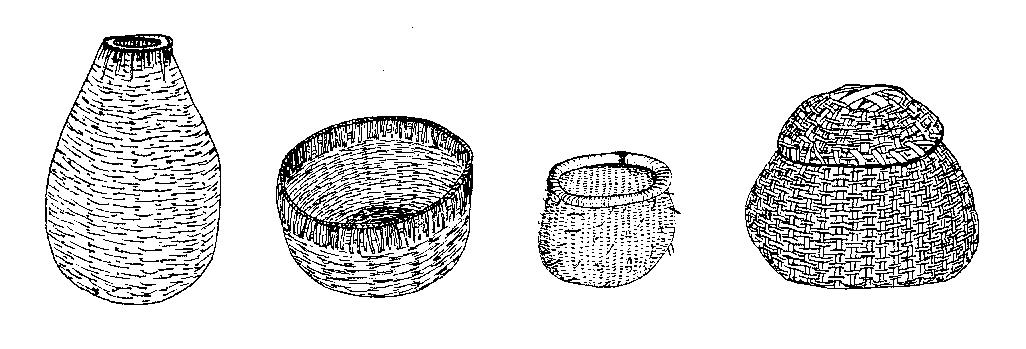 |
|
Fig. 2-5. Bulsa baskets from
left to right: yikoari, kpanjok, chagsik, yi-song |
Baskets with a
rounded base and a circular opening appear to be the norm for Bulsa baskets
(e.g. yikoari, kpanjok, chagsik, yiok) as well as those found in many
other ethnic groups (see Fig. 2-5). Baskets with a flat, circular base and a circular opening
are common in many parts of the world. Likewise, those with a square base and a
square opening, while rarer, can also be found throughout the world. Very
rarely, however, do we find baskets with a square base and a round opening, a
type that is quite common in West Africa, particularly in Northern Ghana and
Burkina Faso1
.
It is called busik by the Bulsa.
What are the causes
for the extraordinary distribution of this type in West Africa?
(1) Is it the simple
and quick method of production? Certainly not, for it takes much more time to
plait a busik than, for example, a kpanjok.
(2) Is its use in a
particular way adapted to Bulsa requirements? With its flat base, the busik
is certainly well-suited for being balanced on a woman's head, for being filled
with harvest products or earth for the mason's building site or as a suitable
container for food. But a basket of similar size and with a rounded base and
wide opening might fulfil the same demands.
(3) Or is there any
religious or mythical significance to this particular form of the basket? Among
the Bulsa, I could not find any religious meanings or mythic stories associated
with the busik.
Marcel Griaule
(1965: 31f.), the French anthropologist, however, was told the following
mythological story about the same type of basket among the Dogon (Mali).
It was then that
the first ancestor, no doubt with the approval and perhaps with the help of
God, began to make preparations for his own departure [from heaven].
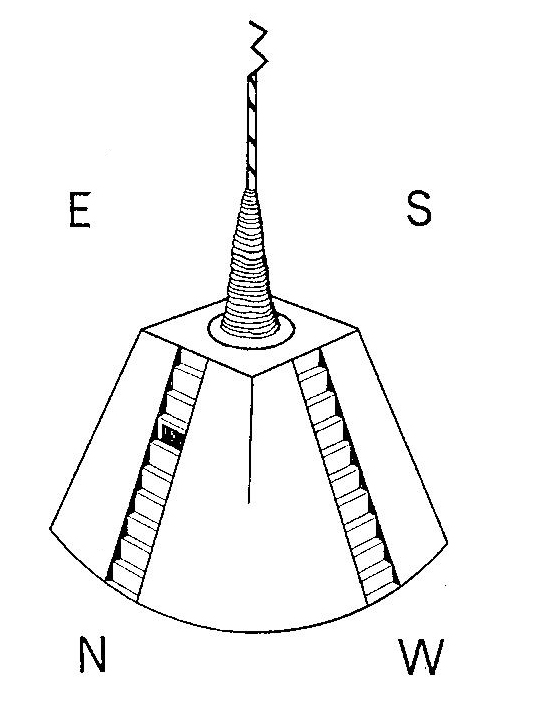 |
|
Fig. 6. The Dogon
world-system (after Griaule1965; 33m Fig. 2) |
He took a woven
basket with a circular opening and a square base in which to carry the earth
and puddled clay required for the construction of a world-system, of which
he was to be one of the counsellors. This basket served as a model for a
basket-work structure of considerable size which he built upside down, as it
were, with the opening, twenty cubits2 in diameter, on the
ground, the square base, with sides eight cubits long, formed a flat roof,
and the height was ten cubits. This framework he covered with puddled clay
made of the earth from heaven, and in the thickness of the clay, starting
from the centre of each side of the square, he made stairways of ten steps
each facing towards one of the cardinal points. At the sixth step of the
north
staircase
he put a door giving access to
the interior in which were eight chambers arranged on two floors.
The symbolic
significance of this structure was as follows:
The circular
base represented the sun.
The square roof
represented the sky.
2.
The Production of the busik3
The unique form of
the busik corresponds to its extraordinary and quite complicated method
of production. While baskets and other plaited objects of the Bulsa are produced
almost entirely by men4, the busik is the product of women,
although after the completion of the actual busik, a man attaches the
wooden base slats to it.
The basic material of the basket
consists of the upper, thin millet stalks which are called kingkapirisa
in Buli. Before beginning her work, the basket-maker gets a bundle of these
stalks in a length suitable for the intended basket and soaks them for one day.
If the basket has been ordered, the customer often provides the material in
order to obtain a more favourable purchase price for the finished basket.
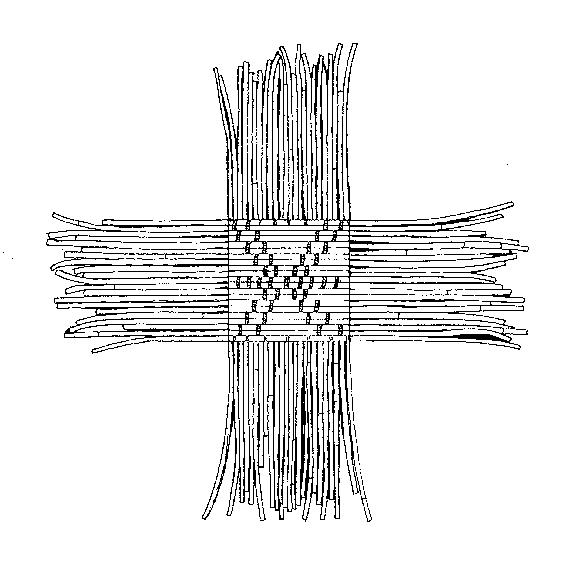 |
|
Fig.7.
The straw cross
|
I was able to observe and document the production of the busik in various
sections of Wiaga. The following description refers primarily to the
manufacturing process in Wiaga-Bachinsa, which was observed on May 5, 1989, with
Akanpaaba as the basket maker.
From a non-twisted fibre strip of the kazaksa plant (Hibiscus
cannabinus), Akanpaaba formed a loop, inserted four thin millet stalks (kingkapirisa)
halfway, drew the loop, and turned two straws by 90° to form a cross with the
other two. Maybe there are other "commencements" in other parts of Bulsaland
with which I’m not familiar. Akanpaaba laid the straw cross on the ground, added
two more kingkapirisa stalks to one side of the two upper stalks of the
cross and interlaced them with a kenaf fibre .
In the next working step, she turned the intermediate product so that the
previous lower pair of straws lay on top. To these two straws, she added another
pair of straws and interlaced them with kenaf until the two layers of straw
formed a square in the middle. In this way, different patterns can be produced
as shown in Fig. 7.
 |
|
Fig. 8-11. Various pattern of interweaving on the bottom
of a busik-basket. View from outside.
|
After soaking the
interstage product, Akanpaaba continued her work. She bent the straws,
projecting up about 30-50 cm from the four square sides. Since the angle was not
quite 90°, she had to add further stalks at the four corners of the square. Like
the bottom, the wall was also built in two layers. Around the nearly vertical
straws, Apaaba laid a spiral of light gula grass blades around the
basket.
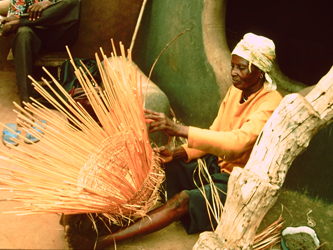 |
|
Fig. 12. Adding the gula-spiral
and interlacing it with the uprights |
After completing about 10-20 cm in gula, Apaaba
continued
with brown and black-coloured vising vain straws (Corochus sp.).
With undrilled kazagsa fibres, she interlaced the crossings of the
horizontal spiral and the vertical stalks of the wall.
About 5 cm before reaching the upper edge, the spiral-shaped, horizontal stalks
ended so that the vertical stalks (prolongations from the bottom) were visible
from both sides without any interweaving (Fig. 13). Kinking, nesting and braiding the ends
of the stalks with kazaksa fibres produced the broad upper edge (koarika)
of the basket.
After concluding her work, Apaaba
carried the not-quite-finished basket to a man from the neighbourhood who would
add the wooden base slats.
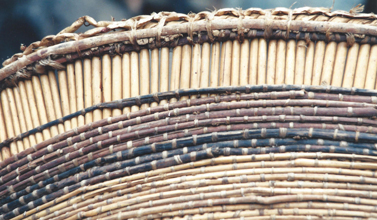 |
|
Fig. 13. After terminating
the gula-spiral the light uprights become visible |
I was able to observe this activity being done by my friend, Akanming. For the
bottom (tuka) of the basket, he made a small mat as a third layer. This
mat consisted of light-brown suom-karisa stalks (unidentified) which had
been interwoven with fibres. Akanming fixed the mat by interweaving its
prolonged ends for about 20 cm into the upright stalks of the wall. They were
stabilized later by the two wooden slats. Akanming made them from the wood of
the gaab tree (Diospyros mespiliformis). With two awls, which were
alternately heated in an open fire, he burned two holes through each wooden
ledge (Fig. 15). He later pulled the threads, which fastened the wooden slats to the
bottom of the
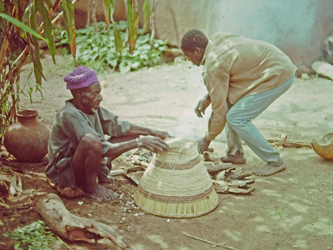 |
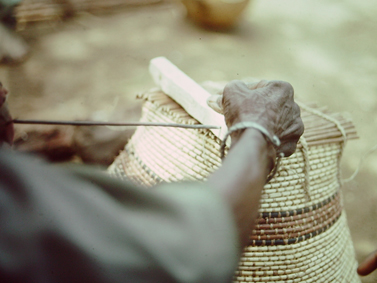 |
|
Fig. 14-15. Akanming is
fixing the wooden slats
|
basket, through these holes and
decorated the slats with simple zigzag patterns burned into the wood. For this
he used heated awls which he placed flat on the slats (Fig. 16).
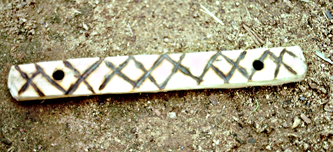 |
|
Fig. 16. Holes and
decorations on a wooden slat |
Sometimes the male manufacturer also
covers the upper edge of the basket with leather if he is experienced in leather
work and the woman would like it.
After his contribution to the completion of the busik, the male craftsman
sends the basket back to the woman who can pay him for his work or render
another service (e.g. cooking a meal for him).
Busik
baskets are seldom offered at the market but rather are almost exclusively made
to order.
3. Decorations
The grass spirals can be arranged in three different colours: natural (gula
grass), brown and black (vising-vain). The originally light-coloured
vising vain straw assumes a brown colour after drying. To dye the straw
black, it is placed in a sigirik or kpa-bi-nyiam5
solution and then, for a few days, in moist black mud (bakta). Many women
who only occasionally make a busik basket buy the brown and black stalks
at the market. Through the use of differently coloured stalks, the walls are
divided into horizontal, coloured zones.
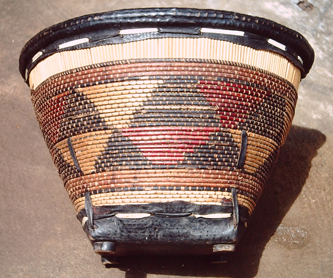 |
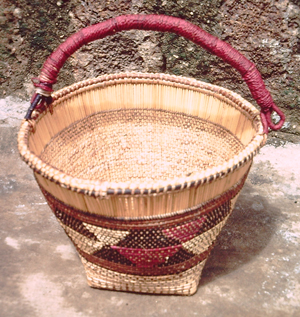 |
| Fig. 17. Busik with leather
base and rim |
Fig. 18. Busik with a handle |
Apart from the
baskets with coloured zones, others are decorated with coloured triangles (Fig.
17-18) on the outer wall. Such a basket is called busik-ngmin-ngmirik
(multi-coloured basket). The triangles colours are always "light" (natural
colour), red6 and black. The coloured pattern (ngmirisika) is
produced as follows: Coloured stalks are cut into different lengths, as required
for the triangular shapes, and split along their length.
Before the interlacing of the
gula and vising-vain stalks with the kazaksa fibres, the
basket maker imposes the open, coloured stalk pieces on the horizontal,
unstained stalks in such a way that the coloured, triangular patterns are
generated. A coloured basket can have two or three rows of triangles.
 |
|
Fig. 19. Flowchart of busik
decoration patterns |
In the case where the coloured triangles do not touch each other, the
arrangement of the red and light triangles on a basket looks quite irregular at
first glance. In the schematized, rolled up "flowcharts", however, the symmetry
of these patterns is evident (Fig. 19).
It can be seen that the respective upper row of triangles is a repetition of the
lower row. In some baskets, isolated light and red triangles seem to have been
placed on a black background (Fig. 20), although the decoration pattern
described above has still been observed.
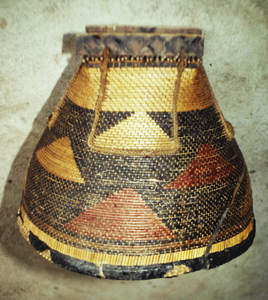 |
|
Fig. 20. Red triangles on a
black background |
4. Use and function
The busik basket is almost
exclusively used by women, though their use by men is not considered taboo (kisuk).
It is primarily a transport basket. It is used less frequently for storage and
then only for short times. Its wide opening makes it ill-suited for many
products.
The Bulsa distinguish between three
types of busik baskets with regard to both function and size:
1. Busik-kpieng (large basket): It has an upper diameter of over one
metre and is used mainly for medium-term storage of e.g. grains or groundnuts.
2. Busik-jieng (cf. ji v., 'carry'): This is the most common type
and is exclusively used for transport. For example, harvest products such as
millet cobs, guinea-corn panicles, groundnuts, beans and small pumpkins (buura)
may be carried from the fields to the compound. Larger quantities are nowadays
transported in donkey carts or by bags which are filled in the fields. During
sowing a busik basket may be placed on the field and filled, for example,
with the mixed seeds of early and late millet, beans and buura
(pumpkins); the women engaged in sowing fill up their small seed calabashes
here.
Women go to the bush with a busik
basket on their heads to collect shea-nuts or edible leaves for their kitchen.
Market women like to use the basket for transporting their goods meant for sale.
The busik is strong enough to be used for the transport of termite clay
as well as sand and gravel for construction work. However, for this function
people like to take older or slightly damaged baskets. Today big basins (or
"head-pans") have replaced the busik for the transport of earth.
3. Busik-fiik ('small basket'): This basket is used for various purposes.
In a woman's bedroom it may store soap, small tools, cosmetics, etc.
When a bride's mother pays her first
official visit to the bridegroom after the wedding, she is given a busik
basket full of unthreshed millet kobs or panicles. A wealthy groom will fill not
only a large basket but will even increase its capacity by adding protruding
millet stalks to the edges7.Shortly before a funeral celebration,
male and female representatives of the mourning house move through areas of
related clans to collect food for the upcoming festivity. For the transport of
the gifts, a busik basket is prescribed: The institutionalized collection
of food is even named after the busik basket. About this event it may be
said: Ba ta wa busika a nyieem ka vonung (The day after tomorrow they
will move with the busik).
4.5 Conclusion
Although the busik-basket is
the typical paradigm for a Bulsa basket, in some spheres of life it has already
been replaced by modern containers.
After a harvest, big quantities of
the crops are nowadays usually filled in jute or plastic sacks, which are either
carried on women’s heads or in (on?) a donkey cart to the barns of the compound.
Earth and wet mud are now often transported in very big, flat aluminium or
enamel basins, called "head-pans" in Bulsa English. The busik as a
container for storing things is frequently replaced by all kinds of plastic
bags, empty metal tin or plastic buckets.
In my opinion, the busik’s
chances of survival are greatest in field with a more or less ritual character:
sowing millet, collecting food for a funeral or as a contain for presents given
to a mother-in-law who visits her daughter for the first time.
ENDNOTES (Busik basket)
1We
find them, for example, among the Mossi, Kasena, Bisa, Lobi, Gulmance, Lodagaa,
Dogon, Nankana, Gouin, Sisala, Birifor, Kurumba, Nyonyosi
2Approximately
0.5 m.
3This and the following
chapter (Use and function) are abridged translations from my book Materielle
Kultur... (2001: 320-24)
4Only the tiak-sleeping mat
can be sewn either by women of men.
5sigirik: Egyptian
Thron Tree (Acacia nilotica); kpa-bi-nyiam: red-brown water, in which
shea butter has been "washed".
6Red dye is gained from the
red leaves of a particular species of millet.
7Cf. Kröger 1978: 278-80.
LITERATURE (Busik-basket)
Griaule, Marcel
1965 Conversations with
Ogotemmêli. An Introduction of Dogon Religious Ideas. London: Oxford
University Press.
Kröger, Franz
1978 Übergangsriten im
Wandel. Kindheit, Reife und Heirat bei den Bulsa in Nord-Ghana.
Hohenschäftlarn bei München: Kommissionsverlag Klaus Renner.
1992 Buli-English Dictionary.
Münster and Hamburg: Lit-Verlag.
2001 Materielle Kultur und
traditionelles Handwerk bei den Bulsa (Nordghana). 2 vols., Münster and
Hamburg: Lit-Verlag.
























